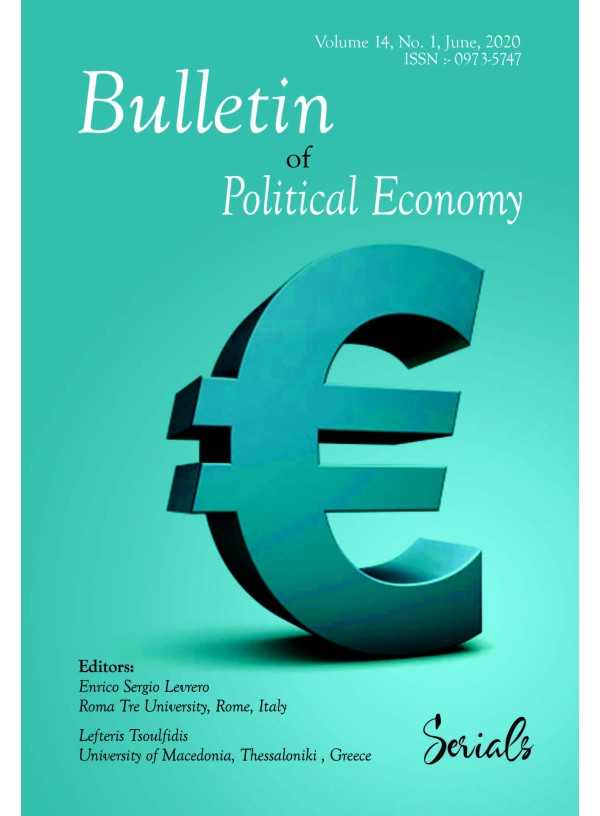
Bulletin of Political Economy
- ISSN :- 0973-5747
- Frequency :- Semi-annual
Articles
Monetary policy and income distribution: an introduction
Author :- Enrico Sergio Levrero
Volume :- No.13 (2019)
Issue No :- 2 (2019)
Pages :- 107-115
On Pasinetti’s ‘natural’ rate of interest
Author :- Enrico Bellino
Volume :- No.13 (2019)
Issue No :- 2 (2019)
Pages :- 117-137
This paper provides a concise exposition of the notion of ‘natural rate of interest’ introduced by Luigi Pasinetti in his structural change analysis. Its normative nature is suitably stressed: it is that rate of interest that prevents that debt and credit relations among individuals alter a distribution of national income based on the ‘labour principle’, that is, a situation where each individual perceives income in proportion to the quantity of labour provided.
Keywords: rate of interest, technical progress, structural change, physical numéraires, nominal numéraires.
J.E.L. classification: B51, D20, D33, E40, E43, E49.
Macroeconomics and natural rates: some reflections on Pasinetti’s fair rate of interest
Author :- Marc Lavoie and Mario Seccareccia
Volume :- No.13 (2019)
Issue No :- 2 (2019)
Pages :- 139-165
Monetary policy based on the Wicksellian natural rate of interest is progressively losing its hold on macroeconomic theory and policy. We advocate a ‘park it’ approach to monetary policy, where the interest rate is not set as a counter-cyclical tool based on this natural rate. The paper presents what has been called the Pasinetti rule, based on his concept of the fair or just rate of interest – a distribution-neutral rate. Central banks should insure that the nominal rate of interest – the long-term government bond rate – is equal to the growth rate of labour compensation.
Keywords: Monetary policy, Income distribution, Pasinetti rule, Fair interest rate
JEL Classification: E11, E12, E25, E43, E58
On Interest as a Monetary Phenomenon and the ‘Best’ Interest-rate Policy
Author :- Massimo Pivetti
Volume :- No.13 (2019)
Issue No :- 2 (2019)
Pages :- 167-187
The article discusses the real effects of interest-rate policy, as well as its impact on inflation, once the traditional concept of a ‘natural’ real rate of interest is discarded and interest is viewed as a monetary phenomenon, a true policy variable subject to a wide range of policy objectives and constraints, which contributes to determine normal production costs. Attention is then focused on the merits of cheap money, whilst it is maintained, by contrast, that a persistent zero real interest-rate policy would ultimately be incompatible with capitalist production. The article concludes by pointing out the implications of the main arguments put forward here for the status of the central bank and the question of capital control.
Keywords: Monetary policy, rate of interest, normal production costs, rate of profits, inflation, cheap money policy, effects of a zero-interest rate policy
JEL Classification: E11, E25, E31, E43, E58, E61
Remarks on Monetary Policy and Fiscal Policy in an Era of Financialisation
Author :- Jalal Qanas and Malcolm Sawyer
Volume :- No.13 (2019)
Issue No :- 2 (2019)
Pages :- 189-208
The paper considers some of the issues for the conduct of monetary and fiscal policy which arise in the era of financialisation. It opens with a critical assessment of the dominant approach to monetary policy, namely inflation targeting underpinned by the ‘new consensus in macroeconomics’. Within that analytical framework the role of the ‘natural rate of interest’ is critically examined. It is argued that that ‘natural rate of interest’ is a construct of a specific analytical framework and as such it lacks validity in reality in so far as that analytical framework does not provide a good approximation to that reality. This is followed by consideration of some of the issues of coordination between fiscal and monetary policies. It is argued that fiscal and monetary policies can not be separated (as is the case with the new consensus). The nature of a post-Keynesian monetary policy in the present era of financialisation, and particularly the developments of securitisation, is discussed.
Keywords: Monetary policy, fiscal policy, securitisation, financialisation
JEL classification: E52, E62, E63
